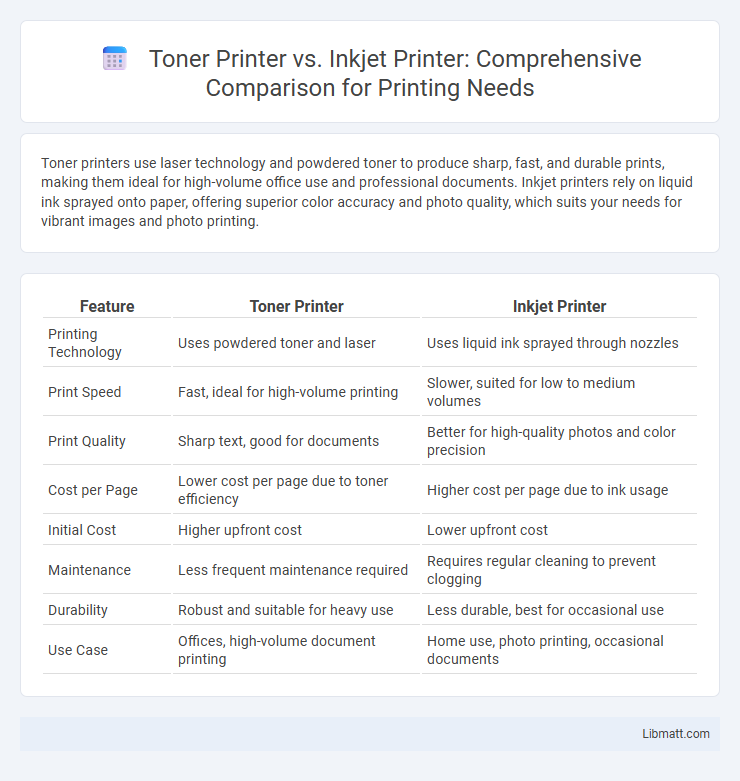Toner printers use laser technology and powdered toner to produce sharp, fast, and durable prints, making them ideal for high-volume office use and professional documents. Inkjet printers rely on liquid ink sprayed onto paper, offering superior color accuracy and photo quality, which suits your needs for vibrant images and photo printing.
Table of Comparison
| Feature | Toner Printer | Inkjet Printer |
|---|---|---|
| Printing Technology | Uses powdered toner and laser | Uses liquid ink sprayed through nozzles |
| Print Speed | Fast, ideal for high-volume printing | Slower, suited for low to medium volumes |
| Print Quality | Sharp text, good for documents | Better for high-quality photos and color precision |
| Cost per Page | Lower cost per page due to toner efficiency | Higher cost per page due to ink usage |
| Initial Cost | Higher upfront cost | Lower upfront cost |
| Maintenance | Less frequent maintenance required | Requires regular cleaning to prevent clogging |
| Durability | Robust and suitable for heavy use | Less durable, best for occasional use |
| Use Case | Offices, high-volume document printing | Home use, photo printing, occasional documents |
Overview of Toner Printers and Inkjet Printers
Toner printers use powdered toner and laser technology, delivering high-speed, precise printing ideal for large volumes and professional documents. Inkjet printers spray liquid ink onto paper, offering vibrant color output and superior photo quality, making them suitable for home and creative projects. Your choice depends on printing needs: toner printers prioritize efficiency and durability, while inkjets excel in color richness and detail.
How Toner Printers Work
Toner printers utilize a laser beam to transfer powdered toner onto paper, where heat fuses the particles to create sharp, durable images and text. This electrophotographic process enables faster printing speeds and higher page yields compared to inkjet printers. Toner particles are finely milled plastic powders that resist smudging, making laser printers ideal for high-volume, professional-quality document production.
How Inkjet Printers Work
Inkjet printers operate by propelling tiny droplets of liquid ink directly onto paper, using precise nozzles controlled by advanced microelectromechanical systems. This technology enables high-resolution color printing ideal for photos and detailed images, with the ink blending seamlessly for smooth gradients. Understanding how your inkjet printer works helps optimize print quality and manage ink usage efficiently.
Print Quality Comparison
Toner printers use laser technology that produces sharper text and precise graphics, making them ideal for professional documents and high-volume printing. Inkjet printers deliver vibrant colors and better photo-quality prints due to their ability to blend liquid inks smoothly on various paper types. While toner printers excel in crisp monochrome output, inkjets are preferred for rich color depth and detailed image reproduction.
Printing Speed Differences
Toner printers typically offer faster printing speeds than inkjet printers, often producing 20 to 30 pages per minute (ppm) compared to inkjet speeds of 5 to 15 ppm. Laser toner technology allows rapid text and graphics printing without the slow drying time required for inkjet ink. Your choice depends on whether you prioritize quick, high-volume printing or detailed, color-rich images.
Cost Per Page: Toner vs Inkjet
Toner printers generally offer a lower cost per page compared to inkjet printers due to their high-yield toner cartridges that last longer and print more pages. Inkjet printers often have a higher cost per page because ink cartridges tend to run out faster, requiring more frequent replacements. Choosing a toner printer can save you money over time if you print large volumes regularly.
Maintenance and Durability
Toner printers offer lower maintenance requirements due to their use of powder toner, which reduces clogging and ink smudges compared to inkjet printers that rely on liquid ink prone to drying out and nozzle blockages. Durability is another advantage of toner printers; their components, including drums and fusers, generally withstand high-volume printing without frequent replacement, while inkjet printers often require regular cartridge changes and cleaning cycles to maintain print quality. You can benefit from the reliability and longer lifespan of toner printers when seeking consistent performance in demanding printing environments.
Ideal Use Cases for Toner Printers
Toner printers excel in high-volume printing environments such as offices and schools due to their fast print speeds and cost-efficiency per page. They are ideal for producing sharp, durable text documents and graphics with consistent quality, making them suitable for professional reports and bulk mailings. Unlike inkjet printers, toner devices handle large print jobs without frequent refills or smudging issues, optimizing workflow and reducing downtime.
Ideal Use Cases for Inkjet Printers
Inkjet printers excel at producing high-quality photos and vibrant color images, making them ideal for photographers, artists, and home users who prioritize detailed and colorful prints. They handle a wide range of media types, including glossy photo paper and textured stationery, providing versatility in creative projects. Your choice of an inkjet printer benefits scenarios where image precision and color accuracy are essential, especially for small-volume printing needs.
Choosing the Best Printer for Your Needs
Toner printers offer faster print speeds and higher page yields, making them ideal for heavy-duty printing and professional environments. Inkjet printers excel in producing vibrant color images and detailed photos, perfect for creative projects and occasional home use. Assess your printing volume, quality requirements, and budget to choose the best printer that aligns with Your specific needs.
toner printer vs inkjet printer Infographic

 libmatt.com
libmatt.com